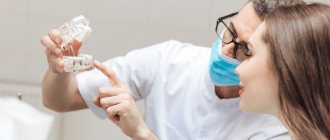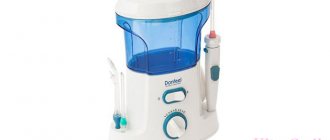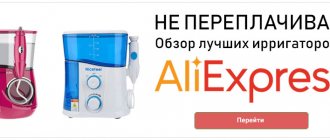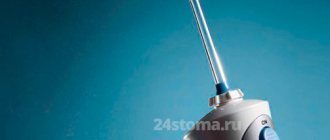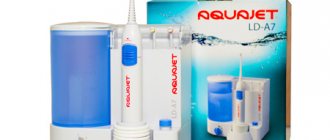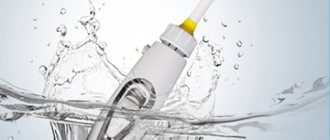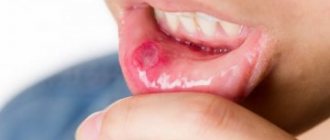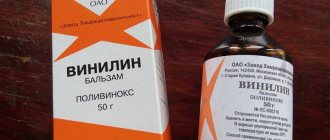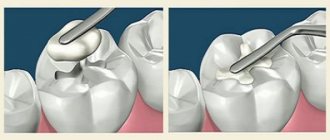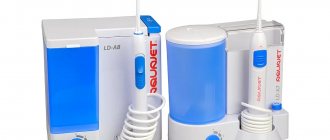Why do you need an irrigator?
- For the prevention of caries. The irrigator helps get rid of plaque on the teeth and tongue. It also cleans hard-to-reach areas such as molars, wisdom teeth, interdental spaces and orthodontic appliances.
- For the prevention and treatment of gum diseases. The irrigator improves blood circulation and accelerates regeneration processes. This helps strengthen the gums and reduce bleeding.
- For the care of implants, crowns, bridges, braces and other structures. The irrigator washes them and the cavities underneath them.
- To eliminate the cause of bad breath - bacterial plaque.
- For the prevention of gingivitis. The disease can occur in pregnant and lactating women due to deterioration of blood supply to the mucous membranes.
There are no contraindications to using the irrigator.
At what age can you use an irrigator?
Although doctors recommend that children start brushing their teeth when the first tooth appears, they can start using a waterpik much later. Some dentists allow the use of the device at the age of three years, but most are inclined to believe that the best age for this method of cleaning is approximately 6-7 years, when baby teeth are replaced by permanent teeth.
Why can't you use an irrigator at an early age? The main reason is the characteristics and structure of the child’s baby teeth.
They begin to erupt approximately 6-9 months after birth, changing to permanent ones between 6-10 years. Compared to permanent teeth, which have strong and hard enamel, baby teeth are quite delicate and vulnerable. Their enamel contains 30% less minerals, which makes it thin and easily damaged. Dentin, which makes up the hard part of the tooth, is quite loose in children, which also contributes to destruction.
It would seem that the vulnerability of children's teeth requires especially careful care. And indeed it is. But an irrigator, which provides thorough and effective cleaning of permanent teeth, can harm milk teeth if used incorrectly.
A jet of water supplied under strong pressure can destroy the thin enamel coating of the tooth, damage delicate gums, cause bleeding and pain. This will not only be harmful to health, but will also provoke a child’s fear of brushing his teeth, which in the future can negatively affect oral hygiene. It is for this reason that many dentists recommend starting to brush your teeth with an irrigator only after 6 years of age.
Types of irrigators
Irrigators are stationary and portable. For home use, it is better to choose a stationary one - it is more reliable and will last longer. Some of these devices can be mounted on the wall. This is useful if you have limited sink space.
If there is no outlet in the bathroom, you can choose a portable irrigator - it runs on a battery and can be charged anywhere. A portable irrigator is lighter and smaller than a stationary one, and is convenient to take on trips.
The first important parameter for choosing an irrigator is the power of the water jet.
.
A portable irrigator must have a power of at least 520 kilopascals (kPa), and a stationary one must have a power of at least 550 kPa. The second selection parameter is the number of jet pulsations
per minute. The optimal value is 1200 pulsations.
Irrigators also differ in their mode switching
. For stationary ones, mode switching occurs smoothly, for portable ones - stepwise. If the waterpik is used by children or people with gum disease, it will be more difficult for them to adjust the comfortable power on a portable one.
Comparison of popular models
To help you make the right choice, we have prepared comparison tables of stationary and portable irrigators. All important characteristics of the devices are listed here.
Stationary irrigators
| Waterpik WP-100 E2 Ultra | Revyline RL 100 | Waterpik WP-660 Aquarius | Revyline RL 500 | Aquajet LD-A8 | B.Well WI-922 | Donfeel OR-820D Compact | Donfeel OR-840 AI | CS Medica AquaPulsar CS-2 | |
| Tank volume, ml | 650 | 600 | 650 | 600 | 500 | 600 | 600 | 600 | 500 |
| Number of nozzles | 7 | 7 | 7 | 7 | 5 | 7 | 8 | 5 | 5 |
| Guarantee | 2 years | 2 years | 2 years | 2 years | 1 year | 2 years | 1 year | 1 year | 2 years |
| Power | from 70 to 690 kPa | from 210 to 870 kPa | from 70 to 690 kPa | from 210 to 870 kPa | from 290 to 810 kPa | from 207 to 827 kPa | from 100 to 650 kPa | 80 - 680 kPa | from 150 kPa to 850 kPa |
| Number of pulsations, min | 1400 | 1200-1700 | 1400 | 1200-1700 | 1200 | 1250-1850 | 1250 — 1550 | 1250 — 1700 | from 1100 to 1600 |
| Wall mount | No | No | No | No | There is | No | No | No | There is |
Portable irrigators
| Waterpik WP-450 | Revyline RL 450 | Philips Sonicare AirFloss Ultra HX8381/01 | Panasonic EW-DJ40 | Panasonic EW1211A | Revyline RL 200XL | B.Well WI-911 | B.Well WI-912 | CS Medica AquaPulsar CS-3 Basic | |
| Tank volume, ml | 210 | 240 | 15 | 165 | 130 | 300 | 150 | 150 | 130 |
| Number of nozzles | 4 | 5 | 1 | 1 | 2 | 2 | 2 | 5 | 2 |
| Guarantee | 2 years | 2 years | 2 years | 2 years | 2 years | 2 years | 1 year | 1 year | 2 years |
| Power | from 310 to 520 kPa | from 130 to 760 kPa | 390 and 590 kPa | from 200 to 590 kPa | from 210 to 700 kPa | 275 - 620 kPa | 378 - 720 kPa | up to 590 kPa | |
| Number of pulsations, min | 1450 | until 1700 | 1400 | 1400 | 1400-1800 | 1600 | 1420 | 1200 — 2000 |
Who needs an irrigator
The use of an irrigator is useful for all people, but is especially indicated for preventive purposes:
- in the presence of braces, crowns, bridges and dentures in the oral cavity;
- when there is an abnormal position of the teeth or their crowding, when there are difficult-to-reach areas for a toothbrush;
- with multiple caries;
- with previously suffered gingivitis and periodontitis;
- in persons who have a tendency to form stones on their teeth;
- in heavy smokers;
- in persons with a tendency to bleeding gums;
- in persons suffering from diabetes mellitus and other metabolic disorders;
- in pregnant women.
Nozzles and their types
The irrigator comes with one or more attachments. Remember that each family member should have their own nozzle. Nozzles can be purchased and changed. They come in several types.
- The standard
brush head is suitable for cleaning healthy teeth and gums. - An orthodontic
attachment is needed to remove plaque under braces and under the gingival margin. For these purposes, you can use a standard attachment, but the orthodontic one is more convenient. - A periodontal
nozzle with a thin soft rubber tip directs the jet beyond the gingival margin and into the periodontal pockets. It should not be used at maximum power - otherwise it may suddenly fly off or tear. - Nozzle for implants
, crowns and bridges - with 3 tufts of bristles for easy cleaning of structures. - The tongue cleaner
removes plaque from the tongue and cheeks, eliminating the cause of the unpleasant odor. - For additional plaque removal there is a brush attachment
. But it does not replace a regular toothbrush. - A nasal nozzle
is needed to irrigate the nasal cavity during the treatment or prevention of rhinitis and sinusitis.
Standard attachments need to be changed approximately every six months, and periodontal, orthodontic and brush attachments - every 3 months. Remember that each family member should have their own nozzle.
Types of removable attachments
Several types of attachments have been developed to perform various oral hygiene tasks:
- The standard one is used for daily brushing of teeth.
- Periodontal is designed to cleanse gum pockets.
- Nozzle for removing plaque from the tongue.
- The orthodontic attachment is used to care for braces and other dental devices.
- The brush attachment performs the work of a classic toothbrush and massages the gums.
- The teeth whitening attachment is used in the process of cleaning and polishing the enamel.
- Manufacturers of irrigators and their features
- In the modern market of dental devices, irrigators are presented in a wide range.
Balms for irrigator
The use of special balms for the irrigator can enhance the effect of the procedure, as their components have antibacterial and anti-inflammatory properties. The choice of liquid depends on your goals. Some liquids help strengthen enamel, others are effective against inflammatory gum diseases, and others have a complex effect. On our website you can buy liquids for irrigators from the companies Waterdent, Donfeel, Professor Persin, Albadent, Asepta, ROCS and Iriks. It is profitable to buy sets of several bottles.
How to choose a liquid for an irrigator
When choosing a liquid for an irrigator, you should take into account its composition and purpose. You should not pour hard running water into the irrigator - it may contain impurities harmful to the enamel, and it can also lead to damage to the device over time. Depending on the active substances, solutions will help solve different problems. They come in 4 types.
- Strengthening enamel
- with fluoride. - Therapeutic and prophylactic
- with antiseptics and plant extracts. - For fresh breath
- with mint, menthol or eucalyptus. - For the treatment of periodontal disease
- with bioantioxidants and anti-caries additives.
Allergy sufferers are advised to choose hypoallergenic balms.
What is a nasal irrigator?
A nasal irrigator is a device designed to cleanse the nasal passages and sinuses of mucus, while simultaneously removing dust, chemicals and pathogenic organisms trapped inside on hairs. Depending on the version, it may have certain design features, but its main parts are a container for liquid that washes the nasal cavity and a nozzle, which is designed to supply liquid directly into the nasal passage. The main indications for using a nasal irrigator are:
- prevention of inflammatory diseases of the nose and paranasal sinuses;
- epidemiological preventive measures;
- prevention of allergic rhinitis;
- prevention of adenoids;
- prevention of the nasal mucosa in dusty conditions.
But, just like any other method of rinsing the nose, using an irrigator has a number of contraindications, the main of which include:
- inflammatory process in the inner ear or acute otitis media;
- increased frequency of nosebleeds;
- absolute obstruction of the nasal passages. In this case, before using the device, it is necessary to drip vasoconstrictor drops into the nose, which will ensure the ability to breathe through the nose;
- neoplasms in the nose.
Increased frequency of nosebleeds is a contraindication for the use of an irrigator
In addition, according to experts from the American College, whose main activity is the study of immunology, asthma and allergies, constant nasal rinsing can cause negative consequences even in people who have no contraindications for performing this procedure. So, based on the research, they were able to conclude that constant rinsing of the nasal sinuses and clearing mucus from them leads not only to the removal of harmful bacteria from the nasal passages, but also beneficial antifungal, antibacterial and antiviral agents. The consequence of this may be a more frequent occurrence of sinusitis in humans. But since the saline solution, which is most often used as a rinsing liquid, is not harmful in itself, this procedure can and should be performed during the treatment process, but the duration of such a course should not exceed 2-3 weeks.
Today, on the consumer market, this device is presented both as an independent mechanical device and as an additional function in other electrical devices, namely:
- aspirator;
- inhaler;
- Oral irrigator.
Each of them has its own characteristics in design and method of application. The result of use is identical - mucus and all foreign particles and microorganisms are washed out of the nose.
Mechanical nasal irrigator
An independent device for rinsing the nose is a plastic flask with a special nozzle, a lid with a tube and a valve. The device comes with two types of attachments, intended for use by adults or children. The way to use it is as follows:
- A solution for rinsing the nose is poured into a plastic flask. It can also be replaced with a composition prepared from 300 ml of purified warm water and 2.7 grams of sea salt;
- an age-appropriate nozzle is put on the irrigator;
- the torso leans forward and the head slightly to the side;
- The irrigator nozzle is inserted into the nasal opening located on top, while holding the flask upside down, after which the valve is pressed;
- after that the procedure is repeated in the same order for the other nasal opening.
Mechanical nasal irrigator
At the moment when the irrigator nozzle is inside the new hole and the solution flows out of it, breathing should be done only through the mouth. In this case, the liquid will, passing and washing the maxillary sinus, flow out of the other nasal opening. All mucus will be removed from the nose along with the fluid. In addition to saline solution, decoctions of medicinal plants such as chamomile, St. John's wort, calendula or string are suitable for rinsing the nose with such an irrigator. But they can only be used if a person has never had an allergic reaction to these components. In case of allergic rhinitis, regardless of the factor that provokes it, the use of decoctions of medicinal plants for rinsing the nose is unacceptable. Also, to prepare a composition for use in an irrigator, you can use furatsilin tablets, which are first thoroughly diluted in warm boiled water.
Furacilin solution is suitable for nasal irrigator
Irrigator in aspirator
The principle of joint operation of the irrigator and aspirator is to irrigate the nasal cavity with liquid and then remove it. In this case, the irrigator sprays liquid poured into one of the device’s containers with a thin stream, ensuring cleaning of even the most inaccessible places, and the aspirator, after changing the nozzle, sucks it into another container. To provide the ability to select the intensity of the liquid jet, there is a special regulator on the device body. Therefore, this device can be used by both adults and children.
The operation of such irrigators can be performed either from an electric current network or from rechargeable batteries, which must be periodically charged. All containers, hoses and nozzles can be separated from each other and boiled, providing the necessary disinfection and keeping the device perfectly clean. In addition to choosing the power, using the irrigator in accordance with age should be done with the appropriate nozzle.
Aspirator-irrigator
Irrigator in inhaler
An inhaler is a device designed to spray medications in the form of a fine aerosol. This transformation is achieved by exposing the liquid to a sufficiently powerful air flow generated by the compressor through a small hole in the nozzle. In most cases, the use of an inhaler is necessary to treat the lower and upper respiratory tract. In order for such a device to be used as an irrigator, the nozzle on it is changed. At the same time, the capacity of the liquid that it contains increases in volume and with it the hole for air supply.
Unlike an aspirator, this device will not remove mucus from the nose. This version of the device is more similar to a mechanical device, with the only difference being that the air flow is not formed by pressing the valve, but directly by the compressor of the device itself. Depending on the age of the person when using the irrigator, an appropriate nozzle is also selected, which helps control the flow of fluid into the nasal passages.
To rinse the nose, the inhaler uses a special separate nozzle with an increased capacity for liquid
Rinse the nose using an oral irrigator attachment
An oral irrigator, which can be powered either by mains or by battery, allows you to simultaneously use a toothbrush and toothpaste to provide complete care for your teeth, gums and the entire mucous membrane. Its operating principle is to supply liquid poured into a container under pressure through a handle on which one or another nozzle is attached. One type of such nozzle is designed for rinsing the nose.
There are currently two types of nasal irrigator attachments. One of them allows you to irrigate the mucous membrane with large drops of water, thereby eliminating congestion, and with it swelling. The second is for washing the nasopharynx, providing liquid in the form of a mist with the formation of very small droplets that settle on the mucous membrane and have a positive effect on it. In the latter case, a solution of sea salt is most often used to rinse the nose.
Nozzles for the nose in the mouth irrigator
Irrigator care
Here are a few rules for caring for your irrigator.
- Do not touch the charger with wet hands
. - Do not allow the plugged-in device to come into contact with water
. - Carefully monitor the integrity of the cord
. - Do not wipe the housing with alcohol
. - Do not place the device near heating devices
. - Fill the reservoir only with water and special balms
for the irrigator. - While the irrigator is operating, do not hold the pause button for long
- the motor may burn out. - Use only attachments recommended by the manufacturer
. - If you take the irrigator on the road in winter, there should be no water in it
- otherwise it will freeze and the device will break. To remove all the water, turn on the irrigator. Let it run until all the liquid comes out.
Differences from a toothbrush
When comparing the effectiveness of irrigators and regular brushes, there are several key factors to consider.
Degree of purification
The device cleans much deeper, allowing you to remove pieces of food stuck between your teeth, in chips or cracks. The effectiveness of the irrigator can be compared with the simultaneous use of dental floss and an electric brush.
Gentle care
The use of an electric toothbrush is contraindicated with some types of dental plates or braces. The irrigator is able to clean any structures in the oral cavity without damaging them. Thus, an irrigator is the only option for solving the problem of cleaning teeth in case of installed braces.
Freshness
An electric toothbrush certainly has a refreshing effect when used with the right toothbrush. However, using an irrigator allows you to achieve a similar effect with plain water.
In order to make your teeth whiter, it is preferable to use not an irrigator, but a brush along with whitening toothpaste
Misconceptions
❌ An irrigator can replace a toothbrush
Using a toothbrush is essential for quality oral care. An irrigator is an additional hygiene product; it can replace dental floss, but not a brush with toothpaste.
❌ It is enough to use the irrigator a couple of times a week
The irrigator should be used every time after brushing your teeth, that is, in the morning and in the evening.
❌ You definitely need to use balms for irrigators
You can use an irrigator with regular warm water. It must be filtered or boiled. Irrigator balms help fight some diseases, but their use is not necessary.
❌ You can pour herbal decoctions and regular rinses into the irrigator
Only water and special balms can be poured into the irrigator. Mouthwashes foam heavily in the reservoir, and herbal infusions leave a sediment. All this can quickly break the device.
❌ The fluid supply hose must be long
The hose should not be too long, as you will still have to bend over the sink when using the irrigator. There is no point in using the device while standing.
❌The more power levels the irrigator has, the better it is
Modern irrigators have smooth power adjustment, and the number of divisions on the toggle switch is quite arbitrary.
How to brush your teeth with an irrigator - step-by-step instructions
- Fill the reservoir with water or a special liquid at a comfortable temperature.
- Select the desired nozzle and install it on the handle of the device.
- Adjust the jet pressure.
- Place the nozzle in your mouth and press it lightly with your lips, then turn on the device.
- Lean over the sink and open your mouth slightly to allow the water to flow into the sink after cleaning.
- Direct the jet towards the teeth at a 90 degree angle. Dentists recommend this cleaning scheme: divide the entire jaw into four parts and treat them one by one. For example, first the upper left part is processed, then the upper right, then you can move on to the lower jaw using the same principle.
- When moving from one tooth to another, you need to stop at the interdental spaces, because Small pieces of food often remain between them and bacterial plaque accumulates.
- After treating the entire oral cavity, remove the nozzle and install it on a special mount.
- Drain the water tank.
Remember! When cleaning your gums, you need to hold the nozzle so that the stream is directed from top to bottom. This precaution will prevent the gum tissue from moving away from the tooth.
Watch the video on how to use an oral
Total: which irrigator is better to choose?
The choice of irrigator depends on your lifestyle, the nature of your dental problems and the number of future users.
Stationary or portable
If you need the device on business trips and trips, choose a portable, travel irrigator. Pay attention to the volume of the tank, the presence of a carrying case and the battery capacity. When choosing a portable irrigator, check whether it has a battery charge indicator. If it is not there, a sudden discharge of the device may be an unpleasant surprise.
If it is possible to install a stationary device at home, choose it, it will last longer. When purchasing, pay attention to the length of the network cable - it should allow you to place the device in a convenient place. The advantages of a stationary irrigator include high power, a spacious tank, and a large selection of nozzles.
Recommendations
- If you need an irrigator for braces
, dentures or crowns, choose an irrigator with a special attachment included. - If you are buying a irrigator for a large family
, choose models with a large tank and the required number of nozzles. - If the irrigator will be used by children or people with gum disease
, the operating mode should be more gentle. The lower the minimum power of the device, the more comfortable they will be. Also in this case, smooth power control is important.
The best inexpensive irrigators (up to 1500 rubles)
In fact, the demand for irrigators has increased significantly over the past few years. Now this useful and effective device can easily be used at home. However, many still doubt the need to purchase this device. Especially for those who want to study and try an irrigator, we offer the TOP 4 best budget models, the cost of which does not exceed one and a half thousand rubles.
FFT-IFI-2000
A good irrigator from the budget segment.
FFT-IFI-2000
The rating of inexpensive irrigators opens with a model from the American brand FFT (Favorite For Teeth) - FFT-IFI-2000 (665 rubles). The key feature of this device is its low cost - you can buy it for six hundred rubles. This is a mechanical irrigator, so it does not need to be recharged, which can be considered a definite advantage. The capacity of the reservoir is, for obvious reasons, very modest - only 90 ml, which, nevertheless, will be enough for one-time use by one person. By the way, the kit includes two replaceable nozzles - one for jet cleaning of the oral cavity, and the other is intended for nasal use.
Main characteristics
- Purpose: for adults
- Irrigator power: none
- Tank capacity: 90 ml
- Jet pressure: 310 - 517 kPa
- Switch on the handle
- Dimensions (WxDxH): 37x28x25 cm
- Weight: 94 g
Video review
Advantages:
- Compact and can be used everywhere.
- Does not require power, the operating principle is mechanical.
- Suitable for nasal use as well.
- Convenience and ease of use.
Flaws:
- Weak pressure.
- Small tank volume.
- The jet of liquid released is too wide.
